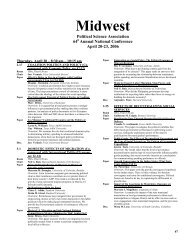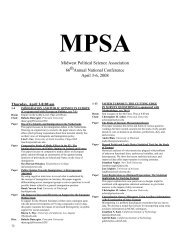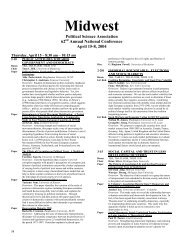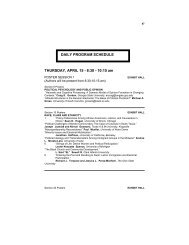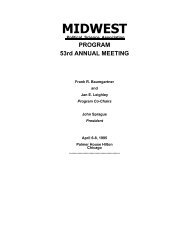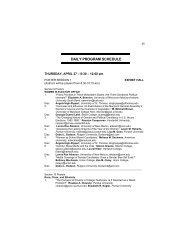2007 Conference Program - Midwest Political Science Association
2007 Conference Program - Midwest Political Science Association
2007 Conference Program - Midwest Political Science Association
You also want an ePaper? Increase the reach of your titles
YUMPU automatically turns print PDFs into web optimized ePapers that Google loves.
38-8 PRESIDENTIAL DELEGATIONS (Co-sponsored with<br />
Public Administration, see 50-21)<br />
Room LaSalle 3, 7 th Floor, Sat at 12:45 pm<br />
Chair Richard Waterman, University of Kentucky<br />
Paper Presidential Staffing and Public Opinion<br />
Justin S. Vaughn, Texas A&M University<br />
Jose D. Villalobos, Texas A&M University<br />
Overview: We examine the influence that the dynamics of<br />
presidential issue approval have on strategic presidential staffing<br />
decisions. To do so, we employ data concerning presidential<br />
appointments to key EOP agencies and issue-specific presidential<br />
approval.<br />
Paper Presidential Unilateralism: Theory and Evidence<br />
Lawrence S. Rothenberg, University of Rochester<br />
Fang-Yi Chiou, Academia Sinica<br />
Overview: The possibility of the president exercising unilateral<br />
action, moving the status quo in a manner not requiring positive<br />
legislative assent and which the judiciary finds acceptable, has<br />
received much recent scholarly attention.<br />
Paper Revisiting the Presidency in the Neoadministrative State<br />
John C. Bumgarner, Virginia Tech University<br />
Overview: The centralization and politicization of the executive<br />
branch and utilization of the unitary executive theory runs counter<br />
to the neoadministrative state; thus, the governing approach of the<br />
presidency must be revisisted.<br />
Paper Seizing Domestic Tranquility: Presidential Military<br />
Intervention during America’s Industrialization<br />
Dan Kenney, Brandeis University<br />
Overview: Utilizing archival data, this paper concentrates on the<br />
last 30 years of the 19 th century when the U.S. experienced the<br />
largest proportion of labor unrest in the industrializing world. It<br />
posits a typological theory of Presidential use of domestic military<br />
intervention that argues such intervention was most likely to when<br />
state-level petitions for troops came in the wake of violence and<br />
when unrest was not tied to a coordinated campaign of<br />
lawlessness.<br />
Disc. Wayne Steger, DePaul University<br />
Richard Waterman, University of Kentucky<br />
39-9 CONGRESSIONAL BUDGETING AND PORK<br />
BARREL POLITICS<br />
Room Montrose 1, 7 th Floor, Sat at 12:45 pm<br />
Chair Diana Evans, Trinity College<br />
Paper Patronage as Representation: Senate Majority Leaders and<br />
Distributive Politics<br />
Andrea C. Hatcher, University of the South<br />
Overview: Using archival data, this paper examines the role of<br />
U.S. Senate Majority Leaders in securing earmarks and<br />
appropriations for their states. Findings suggest both success and<br />
failure in distributive politics carry important electoral<br />
consequences.<br />
Paper Fiscal Effects on Credit-Claiming and Blame-Avoidance in<br />
Appropriations<br />
Stonegarden Grindlife, University of California, Los Angeles<br />
Overview: At what level of reduction in the annual outlays in an<br />
appropriations bill are congressional members activated to engage<br />
in blame-avoidance? What level of growth activates creditclaiming?<br />
Paper The Majority Party and 'the Cohesive Power of Public<br />
Plunder'<br />
Royce A. Carroll, University of California, San Diego<br />
Henry A. Kim, University of California, San Diego<br />
Overview: Examines the relationship between inclusion in<br />
majority policy coalitions and the distribution of targeted<br />
resources.<br />
Paper Congressional Earmarks and the Pursuit of Policy Expertise<br />
Jason A. MacDonald, Kent State University<br />
Overview: A duration analysis of appropriations earmarks is<br />
conducted to assess whether Congress uses earmarks to encourage<br />
the creation of scientific knowledge to address complex policy<br />
problems.<br />
Paper Earmark Explosion: Why Legislative Use of the Earmark has<br />
Skyrocketed in the Last Decade<br />
Wendy R. Ginsberg, University of Pennsylvania<br />
Overview: Using juvenile justice as a case study, this paper aims<br />
to explain the recent burgeoning growth of earmarks, a legislative<br />
tool Congress uses to pinpoint its power of the purse. Earmarks<br />
have taken over entire budgets in some federal offices.<br />
Disc. Diana Evans, Trinity College<br />
Sarah E. Anderson, Stanford University<br />
41-11 SEPARATION OF POWERS IN ACTION<br />
Room Parlor E, 6 th Floor, Sat at 12:45 pm<br />
Chair Kirk A. Randazzo, University of Kentucky<br />
Paper Specifying External Strategic Constraints in Supreme Court<br />
Decision Making<br />
Brandon L. Bartels, Stony Brook University<br />
Overview: Based on a “heterogeneity in decision making”<br />
approach, I provide a theoretical and empirical clarification of<br />
“external strategic constraint” in Supreme Court decision making.<br />
I use a multilevel modeling framework to test the hypotheses.<br />
Paper Beginning at the Beginning: The Decision to Legislate and the<br />
SOP<br />
Bethany Blackstone, Emory University<br />
Overview: A formal model of SOP interactions is employed to<br />
evaluate the conditions under which anticipation of negative<br />
treatment by the Supreme Court leads Congress to refrain from<br />
enacting legislation. Empirical tests use data from the Judiciary<br />
Committees.<br />
Paper Policy Outcomes and the Role of the Public in Court-Congress<br />
Relations<br />
Thomson W. McFarland, University of Colorado, Boulder<br />
Overview: I present a formal model of Court-Congress interaction<br />
that incorporates the level of public support for the Court. I test<br />
the model using a novel dataset including ideal point estimates for<br />
the players involved disaggregated across issue areas.<br />
Paper Judicial Professionalism and Separation of Powers in the<br />
States<br />
Joseph V. Ross, University of Arizona<br />
Overview: This paper offers a measure of state supreme court<br />
professionalism and tests whether an imbalance in resources<br />
across branches of state government leads to retaliatory behavior.<br />
Paper An Empirical Test of the Constitutional Separation of Powers<br />
Model<br />
Jeffrey A. Segal, Stony Brook University<br />
Stefanie A. Lindquist, Vanderbilt University<br />
Chad Westerland, University of Arizona<br />
Overview: We test recent Separation of Powers models, which<br />
argue that the Supreme Court defers to expected Congressional<br />
majorities in deciding Constitutional cases.<br />
Disc. Tonja Jacobi, Northwestern University<br />
Kirk A. Randazzo, University of Kentucky<br />
41-23 ESTABLISHING THE RULE OF LAW AND<br />
PROTECTING RIGHTS (Co-sponsored by Public<br />
Law, see 42-18)<br />
Room Burnham 1, 7 th Floor, Sat at 12:45 pm<br />
Chair Mark C. Miller, Clark University<br />
Paper Judging Democracy in Emerging Democracies<br />
Shannon I. Smithey, Westminster College<br />
Overview: Democratic theorists worry that judicial power will<br />
undermine democratic institutions. Analysis of decisions made by<br />
the Constitutional Courts of Lithuania and the Czech Republic<br />
reveal that courts can actually facilitate democratic development.<br />
Page | 231



